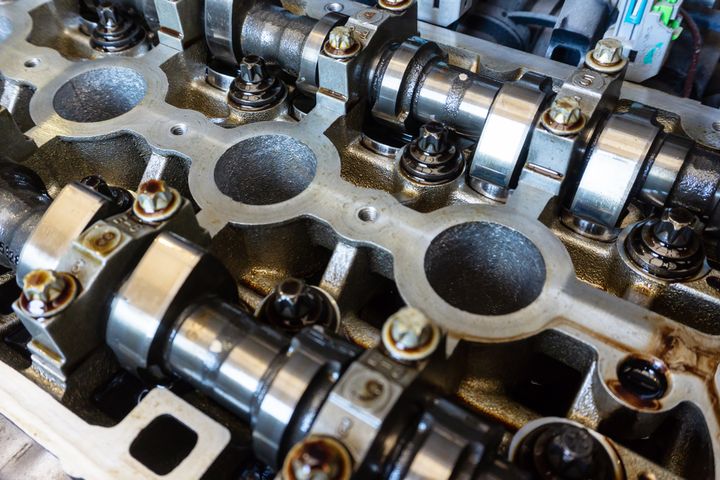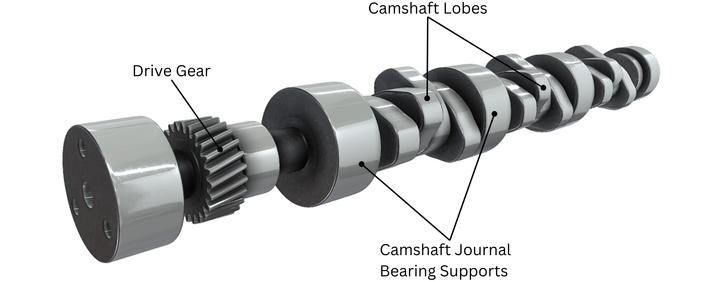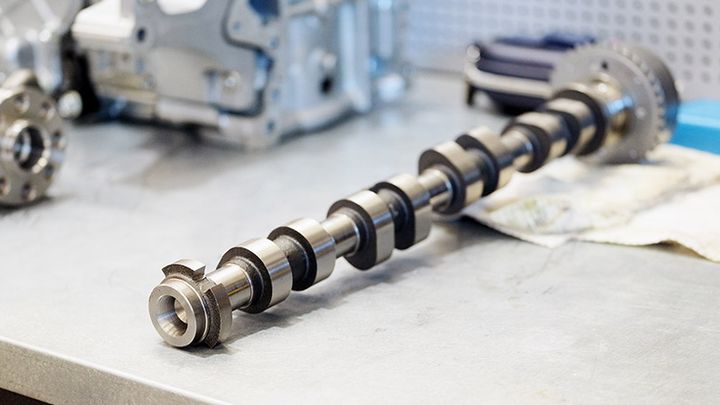


Camshafts are a critical component in internal combustion engines, responsible for precisely controlling the opening and closing of the engine's intake and exhaust valves. This intricate coordination of valve movement is fundamental for an engine's performance, efficiency, and power output. While their modern applications are primarily in automotive and industrial engines, camshafts have been employed in various mechanical devices for centuries, tracing their origins back to the ingenious inventions of the medieval era.

The camshaft is a rotating shaft that controls the precise opening and closing of the engine's valves. It's like the conductor of an intricate symphony, orchestrating the intake and exhaust of air and fuel mixture into and out of the cylinders. Without the camshaft, the engine would be unable to breathe, and the combustion process would grind to a halt.
Imagine the camshaft as a series of carefully designed lobes, each one responsible for actuating a specific valve at the right time. As the camshaft rotates, these lobes push against the valves, opening them to allow the intake of fresh air and fuel or the expulsion of exhaust gases. The timing of these valve events is critical for efficient combustion and power delivery.
Like any hardworking component, the camshaft can face its fair share of challenges over time. Here are some of the most common issues I've encountered in my career:
| Issue | Description |
|---|---|
| Excessive Wear and Tear | The constant friction between the camshaft and its components, such as the lobes, bearings, and lifters, can take a toll over time. As the miles rack up, this wear can cause the camshaft to become misaligned, affecting the timing and efficiency of the engine. |
| Improper Lubrication | Inadequate lubrication can accelerate wear and tear, leading to increased friction and premature failure. Proper lubrication is the lifeblood of any engine component, and the camshaft is no exception. |
| Mechanical Damage | Debris or foreign objects finding their way into the engine, improper installation, or manufacturing defects can all contribute to camshaft issues. |
When it comes to camshaft issues, early detection is key. Here are some diagnostic techniques I employ to identify potential problems:
Visual Inspection
Engine Performance Evaluation
Compression Test
Camshaft Position Sensor Check
A thorough visual inspection can reveal a wealth of information. I carefully examine the camshaft and its components, looking for signs of wear, such as:
Scoring
Pitting
Excessive clearance between the camshaft and its bearings
It's like reading the engine's story through its physical condition.
Listening to the engine's voice can be incredibly insightful. Unusual noises like:
Ticking
Knocking
Rattling
can be telltale signs of camshaft issues. Additionally, symptoms like:
Rough idling
Misfiring
Loss of power
can also point to camshaft-related problems. It's like interpreting the engine's language and deciphering its cries for help.
| Test | Purpose |
|---|---|
| Compression Test | By checking for low compression in the cylinders, I can determine if a faulty camshaft or related components are causing issues. It's a diagnostic tool that helps me pinpoint the root cause of the problem. |
In modern vehicles, the camshaft position sensor plays a crucial role in ensuring proper timing. I always inspect this sensor and its wiring for any issues, as a malfunctioning sensor can wreak havoc on the engine's performance and timing.
Once the issue has been identified, it's time to take action. Depending on the extent of the damage, the camshaft may need to be repaired or replaced entirely.
| Option | Description |
|---|---|
| Repair | Minor wear or damage can sometimes be addressed through resurfacing or reconditioning the camshaft. |
| Replacement | Severe damage or excessive wear often necessitates complete replacement. |
To access the camshaft, the engine needs to be partially disassembled, which can involve removing components like:
Cylinder head
Valve cover
Timing belt or chain
Other related parts
It's a delicate process that requires precision and attention to detail. After the repair or replacement, proper reassembly and timing adjustment are crucial to ensure the engine runs smoothly.
Before installation, I always ensure:

Proper lubrication of the camshaft
Proper lubrication of bearings
Proper lubrication of lobes
Proper lubrication of lifters
Additionally, following the manufacturer's recommended break-in procedures, which may involve running the engine at specific RPM ranges for a certain duration, is essential for optimal performance and longevity.
As the saying goes, "an ounce of prevention is worth a pound of cure." Here are some preventive maintenance tips to help extend the life of your camshaft and avoid costly repairs:
| Tip | Description |
|---|---|
| Regular Oil Changes | Adhering to the recommended oil change intervals and using the correct type of oil can go a long way in preventing excessive wear and tear on the camshaft and its components. |
| Proper Driving Habits | Avoiding excessive engine revving, aggressive driving, and overloading the engine can help extend the life of the camshaft and other engine components. |
| Scheduled Maintenance | Following the manufacturer's recommended maintenance schedule is crucial. This may include inspecting and adjusting the camshaft and related components at specific mileage intervals. |
While preventive maintenance can help extend the life of your camshaft, sometimes replacement is unavoidable. The cost of camshaft replacement can vary significantly depending on several factors:
Vehicle make and model
Labor costs
Parts costs
Additional repairs
| Factor | Description |
|---|---|
| Vehicle Make and Model | Luxury or high-performance vehicles may have more expensive camshafts and higher labor costs. |
| Labor Costs | Camshaft replacement is a labor-intensive job, often requiring partial engine disassembly and reassembly. Labor costs can range from $300 to $2,000 or more, depending on the complexity of the job and the mechanic's hourly rate. |
| Parts Costs | The cost of a new camshaft can range from $100 to over $1,000, depending on the vehicle and whether an OEM or aftermarket part is used. Additional components like timing belts, chains, gaskets, and seals may also need to be replaced, adding to the overall cost. |
| Additional Repairs | If the camshaft failure has caused damage to other engine components, such as the cylinder head, valves, or pistons, the repair costs can increase significantly. |
On average, the total cost of camshaft replacement, including parts and labor, can range from $2,000 to $3,000 or more. It's essential to consult with a qualified mechanic or repair shop to obtain an accurate estimate based on your specific vehicle and the extent of the required repairs.
The camshaft may be a small component in the grand scheme of an engine, but its importance cannot be overstated. As a mechanic, I've witnessed firsthand the impact a faulty camshaft can have on an engine's performance and longevity. By understanding its function, potential issues, and preventive maintenance measures, you can ensure your vehicle runs smoothly for years to come.
Remember, preventive maintenance is key, and addressing issues early can save you from costly repairs down the line. So, the next time you hear that familiar ticking or notice a drop in performance, don't hesitate to bring your vehicle in for a checkup. Your trusty camshaft, and your engine as a whole, will thank you for it.
The camshaft controls the opening and closing of the engine's valves, allowing the intake of air/fuel mixture and expulsion of exhaust gases. It orchestrates the precise timing of these valve events for efficient combustion.
The camshaft has lobes that push against the valves, opening them at the right time as the camshaft rotates. The shape and placement of these lobes determine the timing and duration of valve opening and closing.
The common types are flat-tappet (hydraulic and solid), roller (hydraulic and solid), and variable valve timing (VVT) camshafts.
Roller camshafts have higher load-bearing capacity, allowing higher valve lift and RPM operation. They also experience less friction and wear compared to flat-tappet camshafts.
Hydraulic camshafts offer quiet operation, low maintenance, and compatibility with a non-adjustable valvetrain, making them suitable for street performance applications.
Camshafts are typically driven by the crankshaft through gears, chains, or timing belts/chains, ensuring precise timing between the two components.
Common signs include unusual noises (ticking, knocking, rattling), rough idling, misfiring, and loss of power or performance.
Diagnostic techniques include visual inspection for wear, engine performance evaluation, compression testing, and checking the camshaft position sensor.
It typically requires partial engine disassembly, removal of components like the cylinder head and timing belt/chain, followed by proper reassembly and adjustment.
Regular oil changes, proper driving habits, and following the manufacturer's recommended maintenance schedule can help extend the camshaft's lifespan.

Sarah isn't your average gearhead. With a double major in Mechanical Engineering and Automotive Technology, she dived straight into the world of car repair. After 15 years of turning wrenches at dealerships and independent shops, Sarah joined MICDOT to share her expertise and passion for making cars run like new. Her in-depth knowledge and knack for explaining complex issues in simple terms make her a valuable asset to our team.












